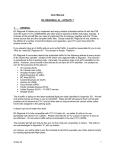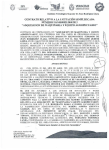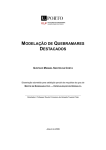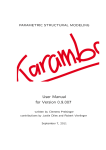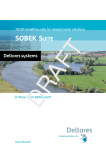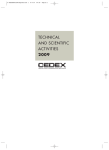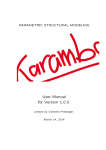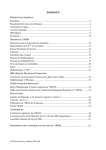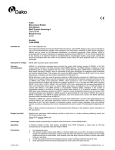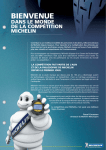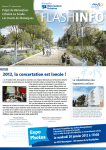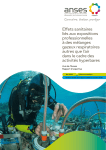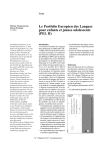Download Análisis y mejoras en la evaluación de diversos términos de los
Transcript
Sección 6 Referencias CAPÍTULO 13 REFERENCIAS Referencias ABBOTT, M.B. y PRICE, W.A. (1994). “Coastal, Estuarial and Harbour Engineers’ Reference Book”. M. B. Abbott y W. A. Price (Eds.). Chapman & Hall. Londres. 736 pp. ABRAMOWITZ, M. y STEGUN, I.A. (1965). “Handbook of Mathematical Functions”. Dover, New York. ARTHUR, R.S. (1950). “Refraction of Shallow Water Waves: the Combined Effects of Currents and Underwater Topography”. American Geophysical Union Transaction , Vol. 31, Nº 4, pp. 549-552. BAILARD, J.A. (1981). “An energetic total load sediment transport model for a plane sloping beach”. Journal of Geophysical Research 86, C11, pp. 938-954. BAILARD, J.A. (1982). “Modelling On-Offshore Sediment Transport in The Surfzone”. Proc. 18th Coastal Engineering Conference, ASCE, pp. 1419-1438. BAKKER, W.T. y EDELMAN, T. (1964). “The Coastline of River Deltas”. Proc. 9th Coastal Engineering Conference, ASCE, pp. 199-218. BAKKER, W.T. (1968). “The Dynamics of a Coast with a Groin System”. Proc. 11th Coastal Engineering Conference, ASCE, pp. 492-517. BAKKER, W.T. (1970). “The Influence of Diffraction near a Harbour Mole on the Coastal Shape”. Rijkswaterstaat Directie Waterhuishouding en Waterbeweging, afd Kustonderzoek, Rapport W.W.K. 70-2. BAKKER, W.T.; KLEIN-BRETELER, E.H.J. y ROOS, A. (1970). “The Dynamics of a Coast with a Groin System”. Proc. 12th Coastal Engineering Conference, ASCE, pp. 1001-1020. BAKKER, W.T.; VAN DER KERK, C. y DE VROEG, J.H. (1988). “Determination of coastal constants in mathematical line models”. Proc. 2nd European Workshop on Coastal Zones, Council of Europe. BASCOM, W. (1959). “The relationship between sand size and beach-face slope”. American Geophysical Union Transaction, Vol. 32, Nº 6, pp. 866-874. - 343 - CAPÍTULO 13 Sección 6 BATTJES, J.A. y JANSSEN, J.P.F.M. (1978). “Energy loss and set-up due to breaking of random waves”. Proc. 16th Coastal Engineering Conference, ASCE, pp. 569-587. BAYRAM, A.; LARSON, M.; MILLER, H.C. y KRAUS, N.C. (2001). “Cross-shore distribution of longshore sediment transport: comparison between predictive formulas and field measurements”. Coastal Engineering, Elsevier, Vol. 44, pp. 79-99. BERKHOFF, J.C.W. (1972). “Computation of Combined Refractiondiffraction”. Proc. 13th Coastal Engineering Conference, ASCE, pp. 471-490. BERKHOFF, J.C.W. (1982).“Verification Computations with Linear Wave Propagation Models”. Report W 154-VIII, Delft Hydraulics Laboratory. BERNABÉU, A.M. (1999). “Desarrollo, validación y aplicaciones de un modelo general de perfil de equilibrio en playas”. Tesis doctoral. Departamento de Ciencias y Técnicas del Agua y del Medio Ambiente. E.T.S.I.C.C.P. Universidad de Cantabria, 169 pp. BIRKEMEIER, W.A. (1985). “Field Data on Seaward Limit of Profile Change”. Journal of Waterway, Port, Coastal, and Ocean Engineering, Vol. 111, Nº 3, pp. 598-602. BIRKEMEIER, W.A. (1991). “DELILAH Investigator’s report (draft)”. Technical Report CERC. US Army Corps of Engineers, Waterways Experiment Station, Vicksburg, MS, USA. BODGE, K.R. y KRAUS, N.C. (1991). “Critical examination of longshore transport rate magnitude”. Proc. Coastal Sediments’91, ASCE, pp. 139-155. BOOIJ, N. (1981). “Gravity Waves on Water with Non-uniform Depth and Currents”. Report Nº 81-1, Delft University of Technology, 131 pp. BOOIJ, N. (1983). “A note on the accuracy of the mild slope equation”. Coastal Engineering, Elsevier, Vol. 7, pp. 191-203. - 344 - Referencias BOON, J.D. y GREEN, M.O. (1989). “Caribbean Beach Face Slopes and Beach Equilibrium Modes”. Proc. 21st Coastal Engineering Conference, ASCE, pp. 1618-1630. BORGMAN, L.E. (1984). “Directional spectrum estimation for the Sxy gauges”. Technical Report CERC. US Army Corps of Engineers, Waterways Experiment Station, Vicksburg, MS, USA, pp. 1-104. BRETSCHNEIDER, C.L. (1959). “Wave variability and wave spectra for wind-generated gravity waves”. Beach Erosion Board, Tech. Memo. US Army Corps of Engineers, Nº 113, 192 pp. BRETSCHNEIDER, C.L. (1968). “Significant waves and wave spectrum”. Ocean Industry, pp. 40-46. BRIAND, M.H.G. y KAMPHUIS, J.W. (1990). “A micro computer based quasi 3-D sediment transport model”. Proc. 22nd Coastal Engineering Conference, ASCE, pp. 2159-2172. BR∅KER-HEDEGAARD, I.; DEIGAARD, R. y FREDS∅E, J. (1991). “Onshore/offshore sediment transport and morphological modelling of coastal profiles”. Proc. Coastal Sediments’91, ASCE, pp. 643-657. BRUUN, P. (1954). “Coast erosion and the development of beach profiles”. Beach Erosion Board, Technical Memorandum, Nº 44. CAPOBIANCO, M.; LARSON, M.; NICHOLLS, R.J. y KRAUS, N.C. (1997). “Depth of Closure: A Contribution to the Reconciliation of Theory, Practise and Evidence”. Proc. Coastal Dynamics’97, ASCE, pp. 506-515. CARSLAW, H. y JAEGER, J. (1959). “Conduction of Heat in Solids”. Clarendon Press, Oxford. CHAWLA, A. (1995). “Wave transformation over a submerged shoal”. M.S. Thesis, University of Delaware, Newark, Del. - 345 - CAPÍTULO 13 Sección 6 CHU, V.C. y MEI, C.C. (1970). “On Slowly Varying Stokes Waves”. Journal of Fluid Mechanics, Vol 41, pp. 873-887. CEM, COASTAL ENGINEERING MANUAL (2002). Part III. Chapter 2. “Longshore Sediment Transport”. US Army Corps of Engineers, Washington, DC, 20314-1000. CRANK, J. (1975). “The Mathematics of Diffusion”, 2ª edición, Clarendon Press, Oxford. DABEES, M.A. y KAMPHUIS, J.W. (1997). “Numerical Modelling and Coastal Processes: Overview of a Modelling System for Simulating Shoreline Change”. Proc. Canadian Coastal Conference 1997, pp. 161-175. DABEES, M.A. y KAMPHUIS, J.W. (1998). “Oneline, a numerical model for shoreline change”. Proc. 26th Coastal Engineering Conference, ASCE, pp. 26682681. DABEES, M.A. y KAMPHUIS, J.W. (1999). “Beach Evolution Modelling”. Proc. Canadian Coastal Conference 1999, pp. 29-42. DABEES, M.A. (2000). “Efficient modelling of beach evolution”. PhD Thesis, Queen’s University, Canada, 174 pp. DABEES, M.A. y KAMPHUIS, J.W. (2000). “Nline: efficient modelling of 3-D beach change”. Proc. 27th Coastal Engineering Conference, ASCE, pp. 27002713. DALLY, W.R. y DEAN, R.G. (1984). “Suspended sediment transport and beach profile evolution”. Journal of Waterway, Port, Coastal and Ocean Engineering, Vol. 110, Nº 1, pp. 15-33. DEAN, R.G. (1973). “Heuristic Models of Sand Transport in the Surf Zone”. Proc. 1st Australian Conference on Coastal and Ocean Engineering, pp. 208-214. - 346 - Referencias DEAN, R.G. (1977). “Equilibrium beach profiles: U.S. Atlantic and Gulf coasts”. Department of Civil Engineering, Ocean Engineering Report Nº 12, University of Delaware, Newark, Delaware. DEAN, R.G. (1984). “CRC Handbook of Coastal Processes and Erosion”. Komar, P.D., editor, CRC Press Inc., Boca Ratón, Florida, USA. DEAN, R.G. (1987a). “Measuring Longshore Transport with Traps”. Nearshore Sediment Transport, Richard J. Seymour, ed., Plenum Press, New York. DEAN, R.G. (1987b). “Coastal sediment processes: Toward engineering solutions”. Proc. Coastal Sediments’87, ASCE, pp. 1-24. DEAN, R.G. y DALRYMPLE, R.A. (1991). “Water Wave Mechanics for Engineers and Scientists”. Advanced Series on Ocean Engineering, Vol. 2, World Scientific, Singapur. DEL VALLE, R.; MEDINA, R. y LOSADA, M.A. (1993). “Dependence of Coefficient K on Grain Size”. Technical Note Nº 3062. Journal of Waterway, Port, Coastal and Ocean Engineering, Vol. 119, Nº 5, pp. 568-574. DE VRIEND, H.J.; ZYSERMAN, J.; NICHOLSON, J.; ROELVINK, J.A.; PÉCHON, P. y SOUTHGATE, H.N. (1993). “Medium-term 2DH coastal area modelling”. Coastal Engineering, Elsevier, Vol. 21, Nº1-3, pp. 193-224. DHI, DANISH HYDRAULIC INSTITUTE (2001). LITPACK “Coastline evolution, User’s Guide and Reference Manual”. Lingby, Dinamarca. DJORDJEVIC, V.D. y REDEKOPP, L.G. (1978). “On the Development of Packets of Surface Gravity Waves Moving over and Uneven Bottom”. Z. Angew. Math. and Phys., Vol 29, pp. 950-962. FISCHER, H.B.; LIST, E.J.; KOH, R.C.Y.; IMBERGER, J. y BROOKS, N.H. (1979). “Mixing in inland and coastal waters”. Academic Press Inc. San Diego, California. - 347 - CAPÍTULO 13 Sección 6 FUNDACIÓN LEONARDO TORRES QUEVEDO. (1988). “Diseño óptimo de la canal de navegación de acceso al Puerto de Santander”. Informe Final para la Junta del Puerto de Santander. Universidad de Cantabria. FUNDACIÓN LEONARDO TORRES QUEVEDO. (1992). “Seguimiento y análisis de la evolución del sistema de playas Loredo-El Puntal y de la canal de navegación del Puerto de Santander, 1990-1992 ”. Informe Final para la Junta del Puerto de Santander. Universidad de Cantabria. GARCÍA, E. (2000). “Modelos morfodinámicos de evolución de playas: perfil y planta”. Tesis doctoral. Departamento de Ciencias y Técnicas del Agua y del Medio Ambiente. E.T.S.I.C.C.P. Universidad de Cantabria, 218 pp. GIOC, Grupo de Ingeniería Oceanográfica y de Costas. (2001a). “Modelo de Propagación de Oleaje Monocromático (Oluca-MC 2.0)”. Manual de Referencia, Modelo de Ayuda a la Gestión del Litoral Español, Edición Universidad de Cantabria-Ministerio de Medio Ambiente, 80 pp. GIOC, Grupo de Ingeniería Oceanográfica y de Costas. (2001b). “Modelo de Propagación de Oleaje Espectral (Oluca-SP 2.0)”. Manual de Referencia, Modelo de Ayuda a la Gestión del Litoral Español, Edición Universidad de CantabriaMinisterio de Medio Ambiente, 170 pp. GIOC, Grupo de Ingeniería Oceanográfica y de Costas. (2001c). “Modelo de oleaje, corrientes y evolución morfológica de una playa (Mopla 2.0)”. Manual de Usuario, Modelo de Ayuda a la Gestión del Litoral Español, Edición Universidad de Cantabria-Ministerio de Medio Ambiente, 279 pp. GIOC, Grupo de Ingeniería Oceanográfica y de Costas. (2001d). “Modelo de evolución del Perfil Transversal de Playa (Petra 2.0)”. Manual de Usuario y Referencia, Modelo de Ayuda a la Gestión del Litoral Español, Edición Universidad de Cantabria-Ministerio de Medio Ambiente, 80 pp. GODA, Y.; TAKAYAMA, T. y SUZUKI, Y. (1978). “Diffraction diagrams for directional random waves”. Proc. 16th Coastal Engineering Conference, ASCE, pp. 628-650. - 348 - Referencias GODA, Y. (1985). “Random seas and design of maritime structures”. University of Tokyo Press. GONZÁLEZ, M. (1995). “Morfología de playas en equilibrio. Planta y perfil”. Tesis doctoral. Departamento de Ciencias y Técnicas del Agua y del Medio Ambiente. E.T.S.I.C.C.P. Universidad de Cantabria, 270 pp. GONZÁLEZ, M.; MEDINA, R. y LOSADA, M. (1997). “Equilibrium Beach Profiles: Effect of Refraction”. Proc. Coastal Dynamics’97, ASCE, pp. 933-942. GONZÁLEZ, M. y MEDINA, R. (2001). “On the application of static equilibrium bay formulations to natural and man-made beaches”. Coastal Engineering, Elsevier, Vol. 43, pp. 209-225. GRAVENS, M.B.; KRAUS, N.C. y HANSON, H. (1991). “GENESIS: Generalized model for simulating shoreline change, Report 2: Workbook and System User’s Manual”. Technical Report CERC-89-19, US Army Corps of Engineers, Waterways Experiment Station, Vicksburg, MS, USA, 345 pp + Apéndices. GRIJM, W. (1960). “Theoretical Forms of Shoreline”. Proc. 7th Coastal Engineering Conference, ASCE, pp. 197-202. GRIJM, W. (1964). “Theoretical Forms of Shoreline”. Proc. 9th Coastal Engineering Conference, ASCE, pp. 219-235. HALLERMEIER, R.J. (1981). “A profile zonation for seasonal sand beaches from wave climate”. Coastal Engineering, Elsevier, Vol. 4, pp. 253-277. HANSON, H. y KRAUS, N.C. (1986a). “Seawall Boundary Condition in Numerical Models of Shoreline Evolution”. Technical Report CERC-86-3. US Army Corps of Engineers, Waterways Experiment Station, Vicksburg, MS, USA. HANSON, H. y KRAUS, N.C. (1986b). “Forecast of shoreline change behind multiple coastal structures”. Coastal Engineering in Japan, Vol. 29, pp. 195-213. - 349 - CAPÍTULO 13 Sección 6 HANSON, H. y LARSON, M. (1987). “Comparison of analytic and numerical solutions of the one-line model of shoreline change”. Proc. Coastal. Sediments’87, ASCE, pp. 500-514. HANSON, H.; GRAVENS, M.B. y KRAUS, N.C. (1988). “Prototype applications of a generalized shoreline change numerical model”. Proc. 21st Coastal Engineering Conference, ASCE, pp. 1265-1279. HANSON, H. (1989). “Genesis - A Generalized Shoreline Change Numerical Model”. Journal of Coastal Research, Vol 5, Nº 1, pp. 1-27. HANSON, H. y KRAUS, N.C. (1989). “Genesis: Generalized Model for Simulating Shoreline Change”. Technical Report CERC-89-19, Report 2 of a Series, Workbook and User’s Manual. US Army Corps of Engineers, Waterways Experiment Station, Vicksburg, MS, USA. HANSON, H.; KRAUS, N.C. y NAKASHIMA, L.D. (1989). “Shoreline change behind transmissive detached breakwaters”. Proc. Coastal Zone’89, ASCE, pp. 568-582. HANSON, H. y KRAUS, N.C. (1991a). “Numerical simulation of shoreline change at Lorain, Ohio”. Journal of Waterway, Port, Coastal and Ocean Engineering, ASCE, Vol. 117, Nº 1, pp. 1-18. HANSON, H. y KRAUS, N.C. (1991b). “Comparison of shoreline change obtained with physical and numerical models”. Proc. Coastal. Sediments’91, ASCE, pp. 1785-1813. HANSON, H. y KRAUS, N.C. (1993). “Optimization of beach fill transitions”. Proc. Coastal Zone’93, ASCE, pp. 103-117. HANSON, H.; LARSON, M.; KRAUS, N.C. y CAPOBIANCO, M. (1997). “Modelling of Seasonal Variations by Cross-Shore Transport Using One-Line Compatible Methods”. Proc. Coastal Dynamics’97, ASCE, pp. 893-912. - 350 - Referencias HANSON, H. y LARSON, M. (1998). “Seasonal Shoreline Variations by Cross-Shore Transport in a One-Line Model under Random Waves”. Proc. 26th Coastal Engineering Conference, ASCE, pp. 2682-2695. HANSON, H. y LARSON, M. (1999). “Extension of GENESIS into the cross-shore dimension from 1-line to N-line”. Coastal Waves, Currents and Sediment Transport, pp. 312-323. HANSON, H. (2000). “Bibliographic Overview of N-line Models and a Presentation of the INLINE Model”. Report Nº EVK3-2000-22014-HUMOR. HANSON, H. y LARSON, M. (2000). “Simulating Shoreline Evolution Using a New Type of N-line Model”. Proc. 27th Coastal Engineering Conference, ASCE, pp. 2808-2821. HANSON, H.; AARNINKHOF, S.; CAPOBIANCO, M.; JIMÉNEZ, J.A.; LARSON, M.; NICHOLLS, R.J.; PLANT, N.G.; SOUTHGATE, H.N.; STEETZEL, H.J.; STIVE, M.J.F. y DE VRIEND, H.J. (2003). “Modelling of Coastal Evolution on Yearly to Decadal Time Scales”. Journal of Coastal Research, Vol. 19, Nº 4, pp. 790-811. HASHIMOTO, H. (1974). “Application of shoreline change model to the detached breakwater construction”. Proc. 21st Japanese Conference on Coastal Engineering, JSCE, pp. 181-185. HASHIMOTO, H. (1976). “Application of a shoreline change model to the Fuji Coast”. Proc. 23rd Japanese Conference on Coastal Engineering, JSCE, pp. 218-222. HASHIMOTO, H. y UDA, T. (1980). “An application of an empirical prediction model of beach profile change to the Ogawara Coast”. Coastal Engineering in Japan, Vol. 23, pp. 191-204. HORIKAWA, K. y KOIZUMI, C. (1974). “An experimental study on the function of an offshore breakwater”. Proc. 29th Annual Conv., JSCE, pp. 85-87. - 351 - CAPÍTULO 13 Sección 6 HORIKAWA, K.; SASAKI, T. y SAKUMOTO, H. (1977). “Mathematical and laboratory models of shoreline change due to dredged holes”. Journal of the Faculty of Engineering, Universidad de Tokio, Vol. 34, Nº 1, pp. 49-57. HORIKAWA, K.; HARIKAI, S. y KRAUS, N.C. (1979). “A physical and numerical modelling of waves, currents and sediment transport near a breakwater”. Annual Report of the Engineering Research Institute, Facultad de Ingeniería de la Universidad de Tokio, Vol. 38, pp. 41-48. HORIKAWA, K. (1988). “Nearshore dynamics and coastal processes. Theory, measurement, and predictive models”. University of Tokyo Press. HSU, J.R.C. y EVANS, C. (1989). “Parabolic bay shapes and applications”. Inst. Civ. Eng. Proc., London, England 87, pp. 556-570 (Part 2). HSU, J.R.C. y SILVESTER, R. (1990). “Accretion behind single offshore Breakwater”. Journal of Waterway, Port, Coastal, and Ocean Engineering, Vol. 116, Nº 3, pp. 326-380. HUGHES, S.A. (1984). “The TMA shallow-water spectrum description and applications”. Technical Report CERC-84-7. US Army Corps of Engineers, Waterways Experiment Station, Vicksburg, MS, USA. HULSBERGEN, C.H.; BAKKER, W.T. y VAN BOCHOVE, G. (1976). “Experimental verification of groyne theory, Proc. 15th Coastal Engineering, ASCE, pp. 1439-1458. JOHNSON, H.K. y KAMPHUIS, J.W. (1988). “N-line morphology model for a large initially conical sand island”. Proc. IAHR Symposium on Mathematical Modelling of Sediment Transport in the Coastal Zone, pp. 275-289. KAMPHUIS, J.W. y READSHAW, J.S. (1978). “A Model Study of Alongshore Sediment Transport Rate”. Proc. 16th Coastal Engineering Conference, ASCE, pp. 1656-1674. KAMPHUIS, J.W. (1991). “Alongshore Sediment Transport Rate”. Journal of Waterway, Port, Coastal, and Ocean Engineering, Vol. 117, pp. 624-640. - 352 - Referencias KAMPHUIS, J.W. (1993). “Effective modelling of coastal morphology”. Proc. 11th Australian Conference on Coastal and Ocean Engineering. KAMPHUIS, J.W. (2000). “Introduction to Coastal Engineering and Management”. Advanced Series on Ocean Engineering, Vol. 10, World Scientific, Singapur. KARAMBAS, T.V. (1999). “Numerical simulation of linear wave propagation, wave-induced circulation, sediment transport and beach evolution”. Coastal Engineering and Marina Developments, WIT Press, Eds C.A. Brebbia and P. Anagnostopoulos, pp. 253-274. KARAMBAS, T.V.; DE LA PEÑA, J.M.; CHRISTOPOULOS, S.; SANTÁS, J.C. y KRESTENITIS, Y.N. (2001). “Malagueta Beach Case: Nourishment Characteristics, Field Surveys and Numerical Simulation”. Proc. Coastal Dynamics’01, ASCE, pp. 182-191. KIRBY, J.T. (1983). “Propagation of weakly-nonlinear surface water waves in regions with varying depth and current”. ONR Tech. Rept. 14, Res. Rept. CE-8337, Department of Civil Engineering, University of Delaware, Newark. KIRBY, J.T. y DALRYMPLE, R.A. (1983). “A Parabolic Equation for the Combined Refraction-Diffraction of Stokes Waves by Mildly Varying Topography”. Journal of Fluid Mechanics, Vol 136, pp. 543-566. KIRBY, J.T. y DALRYMPLE, R.A. (1985). “Modifications to a Propagation Model for the Combined Refraction-Diffraction of Stokes Waves; Shallow Water, Large Angle and Breaking Wave Effects”. Report UFL/COEL-85/001, Coastal and Oceanographical Engineering Department, University of Florida, Gainesville. KIRBY, J.T. (1986a). “Higher-order Approximations in the Parabolic Equation Method for Water Waves”. Journal of Geophysical Research, Vol 91,C1, pp. 933-952. - 353 - CAPÍTULO 13 Sección 6 KIRBY, J.T. (1986b). “Rational approximations in the parabolic equation method for water waves”. Coastal Engineering, Elsevier, Vol. 10, Nº 4, pp. 355378. KIRBY, J.T. y ÖZKAN, H.T. (1994).“Combined refraction/diffraction model for spectral wave conditions. Ref/Dif s version 1.1. Documentation and user’s manual”. Report Nº CACR-94-04, Center Applied Coastal Research, University of Delaware. KOMAR, P.D. e INMAN, D.L. (1970). “Longshore Sand Transport on Beaches”. Journal of Geophysical Research, Vol 75, Nº 30, pp. 5914-5927. KOMAR, P.D. (1973). “Computer Models of Delta Growth Due to Sediment Input from Waves and Longshore Transport”. Geological Society of America Bulletin, Vol. 84, pp. 2217-2226. KOMAR, P.D.; LIZARRAGA-ARCINIEGA, J.R. y TERICH, T.A. (1976). “Oregon coast shoreline changes due to jetties”. Journal of the Waterways, Harbours, and Coastal Engineering Division, ASCE, Vol. 102, Nº WW1, pp. 13-30. KOMAR, P.D. (1977). “Modelling of sand transport on beaches and the resulting shoreline evolution”. In the Seas, eds. Goldberg, E., et alt. v.6, WileyInterscience, New York, pp. 499-513. KOMAR, P.D. (1988). “Environmental Controls on Littoral Sand Transport”. Proc. 21st Coastal Engineering Conference, ASCE, pp. 1238-1252. KOMAR, P.D. (1998). “The Modelling of Processes and Morphology in the Coastal Zone – Reflections on the Maturity of Our Science”, Shore & Beach, pp. 1022. KRAUS, N.C. (1983). “Applications of a shoreline prediction model”. Proc. Coastal Structures’83, ASCE, pp. 632-645. KRAUS, N.C. y HARIKAI, S. (1983). “Numerical model of the shoreline change at Oarai beach”. Coastal Engineering, Elsevier, Vol. 7, pp. 1-28. - 354 - Referencias KRAUS, N.C. (1984). “Estimate of breaking wave height behind structures”. Journal of Waterway, Port, Coastal, and Ocean Engineering, ASCE, Vol. 110, Nº 2, pp. 276-282. KRAUS, N.C.; HANSON, H. y HARIKAI, S. (1984). “Shoreline change at Oarai Beach - Past, present and future”. Proc. 19th Coastal Engineering Conference, ASCE, pp. 2107-2123. KRAUS, N.C. y LARSON, M. (1988). “Prediction of initial profile adjustment of nourished beaches to wave action”. Proc. Annual Conference on Shore and Beach Preservation Technology, Florida Shore and Beach Preservation Association, pp. 125-137. KRAUS, N.C.; GINGERICH, K.J. y ROSATI, J.D. (1989). “DUCK85 surf zone sand transport experiment”. Technical Report CERC-89-5, US Army Corps of Engineers, Waterways Experiment Station, Vicksburg, MS, USA. KRIEBEL, D. (1982). “Beach and Dune Response to Hurricanes”. M. S. Thesis. Department of Civil Engineering. University of Delaware, Newark, DE. KRIEBEL, D.L. y DEAN, R.G. (1984). “Beach and dune response to severe storms”. Proc. 19th Coastal Engineering, ASCE, pp. 1584-1599. KRIEBEL, D.K. y DEAN, R.G. (1985). “Numerical simulation of timedependent beach and dune erosion”, Coastal Engineering, Elsevier, Vol. 9, pp. 221245. LARSON, M.; HANSON, H. y KRAUS, N.C. (1987). “Analytical Solutions of the One-Line model of shoreline change”. Technical Report CERC-87-15. US Army Corps of Engineers, Waterways Experiment Station, Vicksburg, MS, USA. LARSON, M. (1988). “Quantification of beach profile change”. Report Nº 1008, Department of Water Resources Engineering, Universidad de Lund, Suecia. LARSON, M.; KRAUS, N.C. y SUNAMURA, T. (1988). “Beach profile change: morphology, transport rate, and numerical simulation”. Proc. 21st Coastal Engineering Conference, ASCE, pp. 1295-1309. - 355 - CAPÍTULO 13 Sección 6 LARSON, M. y KRAUS, N.C. (1989a). “Prediction of beach fill response to varying waves and water level”. Proc. Coastal Zone’89, ASCE, pp. 607-621. LARSON, M. y KRAUS, N.C. (1989b). “SBEACH: Numerical model for simulating storm induced beach change”. Technical Report CERC-89-9. US Army Corps of Engineers, Waterways Experiment Station, Vicksburg, MS, USA. LARSON, M.; KRAUS, N.C. y HANSON, H. (1990). “Decoupled numerical model of three-dimensional beach range”. Proc. 22nd Coastal Engineering Conference, ASCE, pp. 2173-2185. LARSON, M.; HANSON, H. y KRAUS, N.C. (1997). “Analytical Solutions of One-Line Model for Shoreline Change near Coastal Structures”. Journal of Waterway, Port, Coastal, and Ocean Engineering, ASCE, Vol. 123, Nº 4, pp. 180191. LARSON, M. y WISE, R.A. (1998). “Simple models for equilibrium profiles under breaking and non-breaking waves”. Proc. 26th Coastal Engineering Conference, ASCE, pp. 2722-2735. LARSON, M.; KRAUS, N. y WISE, R.A. (1999). “Equilibrium beach profile under breaking and non-breaking waves”. Coastal Engineering, Elsevier, Vol. 36, pp. 59-85. LEBLOND, P.H. (1972). “On the formation of spiral beaches”. Proc. 13th Coastal Engineering Conference, ASCE, pp. 1331-1345. LE MÉHAUTÉ, B. y BREBNER, A. (1961). “An Introduction to Coastal Morphology and Littoral Processes”. Report Nº 14, Civil Engineering Department, Universidad de Queens en Kingston, Ontario, Canadá. LE MÉHAUTÉ, B. y SOLDATE, M. (1977). “Mathematical Modelling of Shoreline Evolution”. Technical Report CERC-77-10. US Army Corps of Engineers, Waterways Experiment Station, USA. - 356 - Referencias LE MÉHAUTÉ, B. y SOLDATE, M. (1978). “Mathematical Modelling of Shoreline Evolution”. Proc. 16th Coastal Engineering Conference, ASCE, pp. 11631179. LE MÉHAUTÉ, B. Y SOLDATE, M. (1980). “A numerical model for predicting shoreline changes”. Technical Report CERC-80-6. US Army Corps of Engineers, Fort Belvoir, 72 pp. LEPETIT, J.P. (1972). “Transport litoral - essays et calculus”. Proc. 13th Coastal Engineering Conference, ASCE, pp. 971-984. LEONT’YEV, I.O. (1996). “Numerical modelling of beach erosion during storm event”. Coastal Engineering, Elsevier, Vol. 29, Nº 1-2, pp. 187-200. LÓPEZ, B. (1996). “Estudio comparativo de los modelos de evolución de la línea de costa (One-line) y los modelos de forma en planta de equilibrio”. Tesina de magíster. Departamento de Ciencias y Técnicas del Agua y del Medio Ambiente. E.T.S.I.C.C.P. Universidad de Cantabria, 89 pp. LONGUET-HIGGINS, M.S. (1952). “On the statistical distribution of the heights of sea waves”. Journal Marine Research, Vol. 11, Nº 3, pp. 245-265. MASE, H. y KIRBY, J.T. (1992). “Modified frequency-domain KdV equation for random wave shoaling”. Proc. 23rd Coastal Engineering Conference, ASCE, pp. 474-487. MATSUOKA, M. y OCHI, Y. (1979). “Applicability of a shoreline prediction model”. Proc. 26th Japanese Conference on Coastal Engineering, JSCE, pp. 220-224. MATSUOKA, M. y OZAWA, Y. (1983). “Application of a numerical model to prediction of shoreline changes”. Proc. Coastal Structures’83, ASCE, pp. 646659. McCORMICK, M.E. (1993). “Equilibrium Shoreline Response To Breakwaters”. Journal of Waterway, Port, Coastal, and Ocean Engineering, Vol. 119, Nº 6, pp. 657-670. - 357 - CAPÍTULO 13 Sección 6 MICHE, R. (1951). “Le pouvoir réfleéchissant des ouvrages maritimes exposés à l’action de la houle”. Ann. Ponts. Chaussées, 121, pp. 285-319. MILLER, H.C. (1998). “Comparison of storm longshore transport rates to predictions”. Proc. 25th Coastal Engineering Conference, ASCE, pp. 2954-2967. MILLER, H.C. (1999). “Field measurements of longshore sediment transport during storms”. Coastal Engineering, Elsevier, Vol. 36, pp. 301-321. MIMURA, N.; SHIMIZU, T. y HORIKAWA, K. (1983). “Laboratory study on the influence of detached breakwater on coastal change”. Proc. Coastal Structures’83, ASCE, pp. 740-752. MITSUI, H.; OCHI, Y. y KAWAMURA, Y. (1978). “Approximate solution of wave heights around a corner of a seawall and its application”. Proc. 25th Japanese Conference on Coastal Engineering, JSCE. MITSUYASU, H. (1968). “On the growth of the spectrum of wind-generated waves (I)”. Rept. Res. Inst. for Applied Mech. Kyushu University, Vol. XVI, Nº 55, pp. 459-482. MITSUYASU, H.; TASAI, F.; SUHARA, T.; MIZUNO, S.; OHKUSU, M.; HONDA, T. y RIKIISHI, K. (1975). “Observation of the directional spectrum of ocean waves using a cloverleaf buoy”. Journal of Physical Oceanograghy, Vol. 5, Nº 4, pp. 750-760. MOBAREK, I.E. y WIEGEL, R.L. (1966). “Diffraction of wind generated water waves”. Proc. 10th Coastal Engineering Conference, ASCE, pp. 185-206. MOORE, B. (1982). “Beach profile evolution in response to changes in water level and wave height”. M.S. Thesis, University of Delaware. MOPT, (1992). “Recomendaciones para Obras Marítimas ROM 03-91”. Oleaje. Anejo I. Clima Marítimo en el Litoral Español. MOTYKA, J.M. y WILLIS, D.H. (1974). “The effect of refraction over dredged holes”, Proc. 14th Coastal Engineering Conference, ASCE, pp. 615-625. - 358 - Referencias NAGAI, K. (1972). “Diffraction of the irregular sea due to breakwaters”. Coastal Engineering in Japan, Vol. 15, pp. 59-67. NICHOLLS, R.J.; LARSON, M.; CAPOBIANCO, M. y BIRKEMEIER, W.A. (1998). “Depth of Closure: Improving Understanding and Prediction”. Proc. 26th Coastal Engineering Conference, ASCE, pp. 2888-2901. O’ROURKE, J.C. y LEBLOND, P.H. (1972). “Longshore currents in a semicircular bay”. Journal of Geophysical Research, Vol 77, pp. 444-452. OZASA, H. y BRAMPTON, A.H. (1980). “Mathematical modelling of beaches backed by seawalls”. Coastal Engineering, Elsevier, Vol. 4, pp. 47-63. PÉCHON, P. y TEISSON, C. (1996). “Numerical modelling of bed evolution behind a detached breakwater”. Proc. 25th Coastal Engineering Conference, ASCE, pp. 2050-2062. PELNARD-CONSIDÈRE, R. (1956). “Essai de Théorie de l’Évolution des Formes de Rivages en Plage de Sable et de Galets”, 4ème Journées de l’Hydraulique, les Énergies de la Mer, Question III, Reporte nº 1, pp. 289-298. PENNEY, W.G. y PRICE, A.T. (1952). “The Diffraction Theory of Sea Waves and the Shelter Afforded by Breakwaters”. Philos. Trans. Roy. Soc. A, Vol. 244(882), pp. 236-253. PERLIN, M. (1977). “A numerical model to predict beach planforms in the vicinity of littoral barriers”. M.S. Thesis, Department Civil Engineering, Universidad de Delaware. PERLIN, M. y DEAN, R.G. (1978). “Prediction of beach planforms with littoral controls”. Proc. 16th Coastal Engineering Conference, ASCE, pp. 1818-1838. PERLIN, M. (1979). “Predicting beach planforms in the lee of a breakwater”. Proc. Coastal Structures’79, ASCE, pp. 792-808. - 359 - CAPÍTULO 13 Sección 6 PERLIN, M. y DEAN, R.G. (1983). “A numerical model to simulate sediment transport in the vicinity of coastal structures”. Technical Report CERC-8310. US Army Corps of Engineers, 119 pp. PIERSON, W.J. ; NEUMANN, G. Y JAMES, R.W. (1955). “Practical Methods for Observing and Forecasting Ocean Waves by Means of Wave Spectra and Statistics”. U.S. Navy Hydrographic Office, H.O. Pub., Nº 603. PILKEY, O.; YOUNG, R.; RIGGS, S.R.; SAM SMITH, A.W.; WU, H. y PILKEY, W.D. (1993). “The concept of shoreface profile of equilibrium: A critical review”. Journal of Coastal Research, Vol. 9, Nº 1, pp. 255-278. PRICE, W.A.; TOMLINSON, D.W. y WILLIS, D.H. (1972). “Predicting changes in the plan shape of beaches”. Proc. 13th Coastal Engineering Conference, ASCE, pp. 1321-1329. PUTNAM, J.A. y ARTHUR, R.S. (1948). “Diffraction of water waves by breakwaters”. American Geophysical Union Transaction , Vol. 29, Nº 4. RADDER, A.C. (1979). “On the Parabolic Equation Method for Water-Wave Propagation”. Journal of Fluid Mechanics, Vol 95, part 1, pp. 159-176. REA, C.C. y KOMAR, P.D. (1975). “Computer simulation models of a hooked beach shoreline configuration”. Journal of Sedimentary Petrology, Vol. 45, Nº 4, pp. 866-872. ROELVINK, J.A. y BR∅KER, I. (1993). “Cross-shore profile models”. Coastal Engineering, Elsevier, Vol. 21, Nº 1-3, pp. 163-191. ROELVINK, J.A.; WALSTRA, D.J. y CHEN, Z. (1994). “Morphological modelling of keta lagoon case”. Proc. 24th Coastal Engineering Conference, ASCE, pp. 3222-3236. ROELVINK, J.A.; MEIJER, TH. J.; HOUWMAN, K.; BAKKER, R. y SPANHOFF, R. (1995). “Field validation and application of a coastal profile model”. Proc. Coastal Dynamics’95, ASCE, pp. 818-828. - 360 - Referencias ROSATI, J.D.; GINGERICH, K.J. y KRAUS, N.C. (1990). “SUPERDUCK surf zone sand transport experiment”. Technical Report CERC-90-10. US Army Corps of Engineers, Waterways Experiment Station, Vicksburg, MS. SASAKI, T. (1975). “Simulation of Shoreline and Nearshore Current”. Proc. Civil Engineering In the Oceans / III, ASCE, Newark, Del, pp. 179-196. SASAKI, T. y SAKURAMOTO (1978). “Field Verification of a Shoreline Simulation Model”. Proc. International Conference on Water Resources Engineering, pp. 501-518. SAWARAGI, T. (1957). “Effects of Shore Structures on Coastal Sand Drift”. Proc. 4th Japanese Conference on Coastal Engineering, JSCE (Report Nº 1). SCHEFFNER, N.W. y ROSATI, J.D. (1987). “A User’s Guide to the N-line model: A numerical model to simulate sediment transport in the vicinity of coastal structures”. Instruction Report CERC-87-4. US Army Corps of Engineers, Waterways Experiment Station, 125 pp. SHIMIZU, T.; KUMAGAI, T. y WATANABE, A. (1996). “Improved 3-D beach evolution model coupled with the shoreline model (3D-Shore)”. Proc. 25th Coastal Engineering Conference, ASCE, pp. 2843-2856. SHINOHARA, K. y TSUBAKI, T. (1966). “Model Study on the Change of Shoreline of Sandy Beach by the Offshore Breakwater”. Proc. 10th Coastal Engineering Conference, ASCE, pp. 550-563. SOMMERFELD, A. (1896). “Mathematische Theorie der Diffraction”. Math. Ann., Vol. 47, pp. 317-374. SPM (1977). “Shore Protection Manual”. CERC, US Army Corps of Engineers, Waterways Experiment Station, Vicksburg, MS, USA. SPM (1984). “Shore Protection Manual”. CERC, US Army Corps of Engineers, Waterways Experiment Station, Vicksburg, MS, USA. - 361 - CAPÍTULO 13 Sección 6 STEETZEL, H.J.; DE VROEG, J.H. y VAN RIJN, L.C. (1998a). “Pilotversion of the PONTOS model – Definition and preliminary elaboration of a behavior-oriented model for the assessment of the large-scale development of the Dutch coast”. Joint Venture Alkyon Hydraulic Consultancy & Research – WL Delft Hydraulics, Report A066/H3159, 4 Vols, 159 pp. STEETZEL, H.J.; DE VROEG, J.H.; VAN RIJN, L.C. y STAM, J.M. (1998b). “Morphological Modelling using a Modified Multi-layer Approach”. Proc. 26th Coastal Engineering Conference, ASCE, pp. 2368-2381. STEETZEL, H.J. y DE VROEG, J.H. (1999). “Application of a multi-layer approach for morphological modelling”. Proc. Coastal Sediments’99, ASCE, pp. 2206-2218. STEETZEL, H.J.; DE VROEG, J.H.; VAN RIJN, L.C. y STAN, J.M. (2000). “Long-term modelling of the Holland coast using a multi-layer model”. Proc. 27th Coastal Engineering Conference, ASCE, pp. 2942-2955. STIVE, M.J.F. y BATTJES, J.A. (1984). “A model for offshore sediment transport”. Proc. 19th Coastal Engineering Conference, ASCE, pp. 1420-1436. SUH, K.D. y HARDAWAY, C.S. (1994). “Calculation of tombolo in shoreline numerical model”. Proc. 24th Coastal Engineering Conference, ASCE, pp. 2653-2667. SUNAMURA, T. (1984). “Study on cross-shore sediment transport in surf zone including swash zone”. Proc. 31st Japanese Conference on Coastal Engineering, JSCE, pp. 316-320. TAN, S. y CHIEW, Y. (1994). “Analysis of Bayed Beaches in Static equilibrium”. Journal of Waterway, Port, Coastal and Ocean Engineering, Vol. 120, Nº 2, pp. 145-153. TANAKA, N. y NADAOKA, K. (1982). “Development and application of a numerical model for the prediction of shoreline changes”, Technical Note Port and Harbour Research Institute, Ministerio de Transporte de Japón, Nº 436, 40 pp. - 362 - Referencias THORTON, E.B. y GUZA, R.T. (1983). “Transformation of wave height distribution”. Journal of Geophysical Research, Vol 18,C10, pp. 5925-5938. UDA, T.; YAMAMOTO, Y.; ITABASHI, N. y YAMAJI, K. (1996). “Field observation of movement of sand body due to waves and verification of its mechanism by a numerical model”. Proc. 25th Coastal Engineering Conference, ASCE, pp. 137-150. UDA, T.; YAMAGATA, H.; KATOH, K.I. y AKAMATSU, N. (1998). “Predictive model of three-dimensional development and deformation of a river mouth delta by applying contour line change model”. Proc. 26th Coastal Engineering Conference, ASCE, pp. 3138-3151. VAN DE GRAAF, J.; STITZEL, H.; BLIEK, B. y DE VROEG, H. (1998). “Shore parallel breakwaters & beach nourishments”. Proc. Coastal Sediments’99, ASCE, pp. 1706-1719. VAN RIJN, L.C. (1993). “Principles of sediment transport in rivers, estuaries and coastal seas”. Aqua Publications (Eds.). Amsterdam. VELLINGA, P. (1983). “Predictive computational model for beach and dune erosion during storm surges”. Proc. Coastal Structures’83, ASCE, pp. 806-819. VELLINGA, P. (1984). “A Tentative Description of a Universal Erosion Profile for Sandy Beaches and Rock Beaches”. Coastal Engineering, Elsevier, Vol. 8, Nº2, pp. 177-188. VEMULAKONDA, S.R.; SCHEFFNER, N.W.; EARICKSON, J.A. y CHOU, L.W. (1988). “Kings bay coastal processes numerical model”. Technical Report CERC-88-3. US Army Corps of Engineers, Waterways Experiment Station, Vicksburg, MS, USA. VINCENT, C.L. y BRIGGS, M.J. (1989). “Refraction-diffraction of irregular waves over a mound”. Journal of Waterway, Port, Coastal and Ocean Engineering, Vol. 115, Nº 2, pp. 269-284. - 363 - CAPÍTULO 13 Sección 6 WALTON, T. y CHIU, T. (1979). “A review of Analytical Techniques to Solve the Sand Transport Equation and Some Simplified Solutions”. Proc. Coastal Structures’79, ASCE, pp. 809-837. WALTON, T. (1994). “Shoreline Solution for Tapered Beach Fill”. Journal of Waterway, Port, Coastal, and Ocean Engineering, ASCE, Vol. 120, Nº 6, pp. 651655. WATANABE, A. (1988). “Part III: Numerical Model of beach topography change”. Chapter 5, In: K. Horikawa, Ed., Nearshore Dynamics and Coastal Processes: Theory Measurement and Predictive Models, Universidad de Tokio Press, Tokio, Japón, pp. 303-318. WEESAKUL, S. y RASMEEMASMUANG, T. (2002). “Numerical Computation of Crenulate Bay Shape”. Proc. 28th Coastal Engineering Conference, ASCE, pp. 3259-3272. WEISHAR, L.L. y BYRNE, R.J. (1978). “Field Study of Breaking Wave Characteristics”. Proc. 16th Coastal Engineering Conference, ASCE. WILLIS, D.H. (1977). “Evaluation of alongshore transport models”. Proc. Coastal Sediments’77, ASCE, pp. 350-365. WILSON, B.W. (1965). “Numerical prediction of ocean waves in the North Atlantic for December, 1959”. Deutsche Hydr. Zeit., Jahrg., 18, Ht. 3, pp. 114-130. WINYU, R. y TOMOYA, S. (1998). “Energy dissipation model for regular and irregular breaking waves”. Coastal Engineering, Elsevier, Vol. 40, Nº4, pp. 327346. WISE, R. A., SMITH, S. R. y LARSON, M., (1996). “Sbeach: Numerical model for simulating storm-induced beach change”. Technical Report CERC-89-19, Report 4: Cross Shore Transport Under Random Waves and Model Validation with Supertank and Field Data. US Army Corps of Engineers. - 364 - Referencias YAMAMOTO, Y.; HORIKAWA, K. y TANIMOTO, K. (1996). “Prediction of shoreline change considering cross-shore sediment transport”. Proc. 25th Coastal Engineering Conference, ASCE, pp. 3405-3418. ZHENG, J. y DEAN, R.G. (1997). “Numerical Models and Intercomparisons of Beach Profile Evolution”, Coastal Engineering, Elsevier, Vol. 30, pp. 169-201. - 365 - CAPÍTULO 13 Sección 6 - 366 -





























